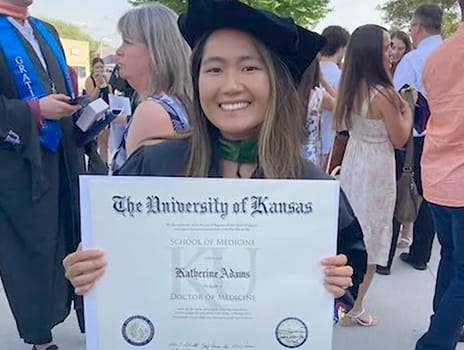June 06, 2024
Kat Adams, MD, resident at The University of Kansas Health System, grew up in Manhattan, Kansas, as an active teen who participated in cheerleading and gymnastics. When she was teenager, however, her life changed overnight.
“I woke up with this horrible pain on the back of my leg,” Kat says. “I was very active growing up, and I couldn’t straighten my leg without crying.”
At age 14, she learned that a disc in her lower back was herniated. She soon learned she had degenerative disc disease. After 3 surgeries in the following year, the pain still didn’t subside. Over the following years, Kat managed the best she could by limiting her activity, which also limited her life.
“I didn’t realize how much it was holding me back from doing all the things that regular teenagers and young adults wanted to do, even in college,” Kat says.
Since I had the implant, I feel great. I’ve been able to complete medical school and do everything I want to in life, and that’s something that hadn’t been possible before I got the implant.” Kat Adams
She continued through college and her first 2 years of medical school at the University of Kansas Medical School without being too bothered by her limitations. She knew the physical demands of a third- and fourth-year medical student wouldn’t be possible in her condition.
Kat sought help from Usman Latif, MD, who specializes in pain management and had been treating Kat since she moved from Manhattan to attend medical school. Dr. Latif told Kat about a trial that might give her some relief – spinal cord stimulation.
A spinal cord stimulator is a device that is implanted near the spinal cord, and a remote control manages the frequency of the pulses sent to the spine to relieve pain. When a person has pain, those signals are transmitted along nerves to the spinal cord.
The stimulator places impulses along the path those pain pulses travel and make it harder for those signals to reach the brain. It also has some local effects on other types of neurons that have an inhibitory action so the stimulator inhibits pain at the spinal cord as well.
Kat:
My life has definitely not been normal.
Narrator:
Growing up in Manhattan, Kansas, Kat Adams was an active teen into cheerleading and gymnastics. But overnight, her life completely changed.
Kat:
I woke up with just this horrible pain down the back of my leg. I was very active growing up, and I couldn't straighten my leg without crying.
Narrator:
A disc in Kat's lower back was herniated, and she soon learned she had degenerative disc disease. Kat had three surgeries that following year, but the pain didn't subside. Over the last decade, Kat had managed her pain as best she could, limiting her activity and her life.
Kat:
I didn't realize how much it was holding me back doing all the things that regular teenagers and young adults wanted to do, even in college.
Narrator:
None of that bothered Kat until she finished her second year of school at KU Med. She knew the physical demands of a third- and fourth-year med student wouldn't be possible unless something changed.
Kat:
It was definitely daunting. I don't believe I would have been able to make it through.
Narrator:
Kat sought help from Dr. Latif, who had been treating Kat since she moved from Manhattan, Kansas, to attend KU Med. He suggested a new trial that might just help – spinal cord stimulation. A device is implanted near the spinal cord and a remote controls the frequency of the pulses sent to the spine to relieve pain.
Kat:
The moment it really hit me was after they had removed everything and I said, “Wow, I really noticed a shift in between when I had the stimulation leads in and when I didn't.” And I hadn't had that much relief since I was in high school.
Narrator:
After her one-week trial, Kat was implanted with a permanent device. She was able to finish med school and just started her residency at KU Med, where she now works with the doctor who made it all possible.
Kat:
I am definitely incredibly grateful to Dr. Latif. From the moment I met him, he was incredibly kind and compassionate and understanding. He was really able to understand what it is that I wanted to achieve. And he had the different options laid out that said, “Okay, here's the route we can go that we think we can get you there.”
Eventually, the battery on Kat’s device will need to be changed. Dr. Latif says changing the battery is a minor procedure that takes about 30 minutes with the patient under anesthesia.
“Since I had the implant, I feel great,” Kat says. “I’ve been able to complete medical school and do everything I want to in life, and that’s something that hadn’t been possible before I got the implant.”
Kat says recovering from the procedure took a little bit of time, but when she felt fully recovered, she could feel a significant difference. The device has a rechargeable battery, and Kat says it’s easy to tell when she’s not diligent about recharging.
“I don’t feel anything when the implant is sending the impulses,” Kat says. “I can go about my day and not have to think about it.”
Kat is now a colleague of the physicians who continue to treat her. “I’m honored to work with these incredible people and I’m eternally grateful for what they’ve been able to give me, which is my life,” she says.
Dr. Latif is complimentary of Kat and all she’s accomplished. “I think it’s great to see what Kat has accomplished,” he says. “It’s not an easy feat regardless of what therapy we were able to provide her. I’m really proud of her and it makes me really happy about our field.”





